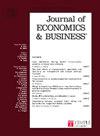混合所有制是一种有利可图的所有制结构吗?——来自中国的经验证据
IF 3.4
Q1 BUSINESS, FINANCE
引用次数: 0
摘要
尽管私有化已经进行了近20年,但混合所有制改革最近一直是中国国有企业改革的主要内容。这就提出了一个问题,即混合所有制企业(Mixed companies)的财务绩效是否优于私营企业(POEs)。尽管混合企业更容易受到政府干预、产权不清、公私股东利益冲突的影响,但它们也能从国家控制的外部资源中受益。因此,混合企业的绩效仍不明朗。我们从中国a股上市市场收集数据,将企业分为国有控股企业、国有控股的混合企业(mixedsoe)和私营控股的混合企业(MixedPOEs)。使用ROA和ROE衡量盈利能力,我们发现POEs的表现优于混合公司,混合POEs的盈利能力高于混合国企。更好的公司治理是解释我们业绩的主要渠道。我们用几种方法解决了内生性挑战,并得到了类似的结果。总的来说,我们的分析为混合所有制企业的财务绩效提供了新的证据。本文章由计算机程序翻译,如有差异,请以英文原文为准。
Is mixed-ownership a profitable ownership structure?—Empirical evidence from China
Despite nearly twenty years of privatization, mixed-ownership reform has recently been China's mainstay of SOE reform. This raises the question of whether the financial performance of mixed-ownership firms (Mixed firms) is better than that of private-owned enterprises (POEs). Although Mixed firms suffer more from government intervention, unclear property rights, and interest conflicts between state and private shareholders, they can also benefit from the external resources controlled by the state. Therefore, the performance of Mixed firms is still unclear. Collecting data from the Chinese A-share listed market, we divide the firms into POEs, Mixed firms controlled by the state (MixedSOEs), and Mixed firms controlled by the private sectors (MixedPOEs). Measuring profitability using ROA and ROE, we find that POEs perform better than Mixed firms, and MixedPOEs have a higher profitability than MixedSOEs. Better corporate governance is the primary channel that can explain our results. We address the endogeneity challenge in several ways and get similar results. Overall, our analysis provides new evidence on the financial performance of mixed-ownership firms.
求助全文
通过发布文献求助,成功后即可免费获取论文全文。
去求助
来源期刊

JOURNAL OF ECONOMICS AND BUSINESS
BUSINESS, FINANCE-
CiteScore
6.20
自引率
2.60%
发文量
31
期刊介绍:
Journal of Economics and Business: Studies in Corporate and Financial Behavior. The Journal publishes high quality research papers in all fields of finance and in closely related fields of economics. The Journal is interested in both theoretical and applied research with an emphasis on topics in corporate finance, financial markets and institutions, and investments. Research in real estate, insurance, monetary theory and policy, and industrial organization is also welcomed. Papers that deal with the relation between the financial structure of firms and the industrial structure of the product market are especially encouraged.
 求助内容:
求助内容: 应助结果提醒方式:
应助结果提醒方式:


